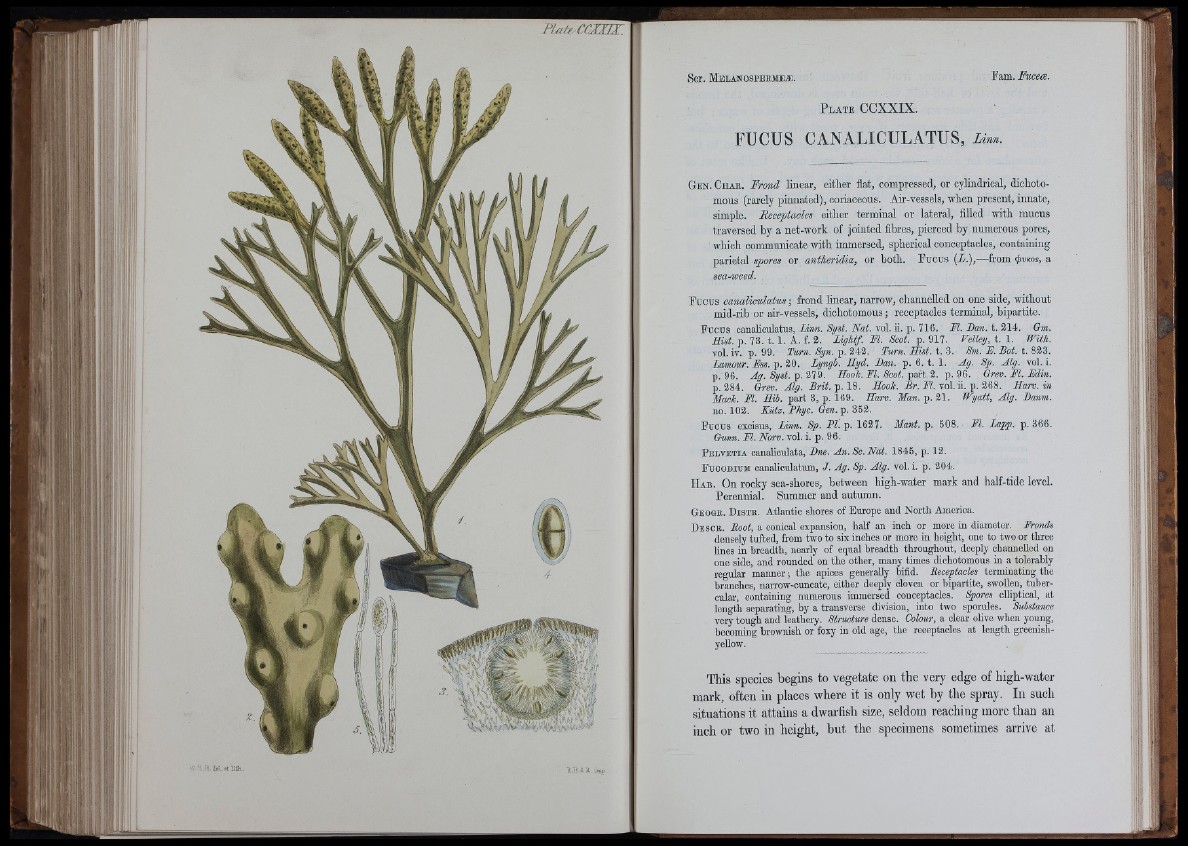
P l a t e CCXXIX.
F U C U S C A N A L I C U L A T U S , Linn.
Gbn. C h a r . Frond linear, either flat, compressed, or cylindrical, dichotomous
(rarely pinnated), coriaceous. Air-vessels, when present, innate,
simple. Reeeptacles either terminal or lateral, filled with mucus
traversed by a net-work of jomted fibres, pierced by numerous pores,
which communicate with immersed, spherical conceptacles, containing
parietal spores or antheridia, or both. F u c u s (A.),—from <#>®Kor, a
Fuous canaliculatus; frond linear, narrow, channelled on one side, without
mid-rib or air-vessels, dichotomous; receptacles terminal, bipartite.
Fucus canaliculatus,
i m . p. 73. 1 .1. A. f. 2.
vol. iv. p. 99. Turn. S\
Lamour. Ess. p. 20.
p. 96. Ag. Syst. p. 279.
Syst. Nat. vol. ii. p. 716. El. Ban. t. 314.
lig h tf. El. Scot. p. 917. Felley, t. 1. With,
m. p. 242. Turn. Hist. t. 3. Sm. E. Bot. t. 823.
). Hyd. Ban. p. 6. t. 1. Ag. Sp. Alg. vol.i.
Hook. Fl. Scot. part 2. p. 96. Grm. Fl. Edin.
p. 284. Grev. Alg. Brit. p. 13. Hook. B r .F l.y o \.n .jg . 293. Harv. in
Mack. El. H ii. part 3, p. 169. Harv. Man. p. 21.
t, Alg.
no. 102. Kiitz. Fhyc. Gen. p. 352.
F u o u s excisus, Linn. Sp. PI. p. 1627. Mant. p. 508.
El. Lapp. p. 366.
Gunn. El. Norv. vol. i. p. 96.
P elvetia canaUculata, Bne. An. Sc. Nat. 1845, p. 12.
F u c o d ium canalioulatum, J . Ag. Sp. Alg. vol. i. p. 204.
I Ia b . On rocky sea-shores, between high-water mark and half-tide level.
Perenmal. Summer and autumn.
Geoor. D is t e . Atlantic shores of Europe and North America.
D e so e . Boot, a conical expansion, half an inch or more in diameter. Eronds
densely tufted, from two to six inches or more in height, one to two or three
lines in breadth, nearly of equal breadth throughout, deeply channelled on
one side, and rounded on the other, many times dichotomous in a tolerably
regular m anner; th e apices generaUy bifid. Receptacles terminating the
branches, narrow-cuueate, either deeply cloven or bipartite, swoUen, tu b e rcular,
containing numerous immersed conceptaoles. Spores elliptical, at
length separating, by a transverse division, into two sporules. Substance
very tough and leathery. Structure dense. Colour, a clear olive when young,
becoming brownish or foxy in old age, the receptacles at length greenish-
yeUow.
This species begins to vegetate on the very edge of high-water
mark, often in places where it is only wet by the spray. In such
situations it attains a dwarfish size, seldom reaching more than an
inch or two in height, but the specimens sometimes arrive at